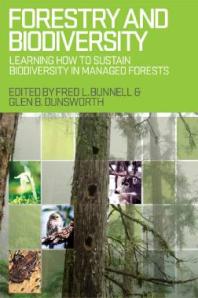

Most ebook files are in PDF format, so you can easily read them using various software such as Foxit Reader or directly on the Google Chrome browser.
Some ebook files are released by publishers in other formats such as .awz, .mobi, .epub, .fb2, etc. You may need to install specific software to read these formats on mobile/PC, such as Calibre.
Please read the tutorial at this link. https://ebooknice.com/page/post?id=faq
We offer FREE conversion to the popular formats you request; however, this may take some time. Therefore, right after payment, please email us, and we will try to provide the service as quickly as possible.
For some exceptional file formats or broken links (if any), please refrain from opening any disputes. Instead, email us first, and we will try to assist within a maximum of 6 hours.
EbookNice Team

Status:
Available4.7
22 reviews
ISBN 10: 0774815310
ISBN 13: 9780774815314
Author: Fred L Bunnell, Glen B Dunsworth
Sustainable management is a problem for countries that depend on natural resources. Forests contain most of the world’s biodiversity and offer significant renewable resources with a potentially small ecological and carbon footprint. Yet the global demand for forest products has increased while the need to conserve biodiversity and endangered species has become more urgent and challenging. Sustainable management in the forestry sector is complicated by the size and slow growth of commercial forests. Forestry and Biodiversity makes the case for adaptive management – a structured approach to learning by doing – to sustain biodiversity in managed forests. It draws on the theory and principles of conservation biology and forest ecology and illustrates them, and the challenges they present, through a practical, real-world study of a 1.1 million hectare commercial operation in a coastal temperate rainforest. The authors present the results honestly – not everything worked as intended – the problems they encountered suggest where the boundaries of science stop and social choices must be made. Forestry and Biodiversity describes an innovate program for sustaining biodiversity in managed forests that will be of interest to those who plan, or hope to influence, forest practices and to those who are concerned with wildlife, climate change, and the environment.
Part 1: Introduction
1 The Problem
1.1 “Wicked” Problems
1.2 Expanding and Competing Values
1.3 Special Difficulties in Forests
1.4 Adaptive Management
1.5 Bounding the Book: What It Is and Is Not
1.6 Summary
2 The Example
2.1 Physical and Ecological Setting
2.2 Social and Historical Contexts
2.3 New Planning and Practices
2.4 Structures to Make It Work
2.5 Monitoring
2.6 Summary
3 The Approach
3.1 Managers’ Questions
3.2 Establishing Objectives and Measures of Success
3.3 Deciding on Actions
3.4 Evaluating Success
3.5 Linking Findings to Actions
3.6 Summary
4 Implementing the Approach
4.1 Change in Midstream
4.2 Progress in Adopting the Approach
4.3 Assessing the Outcomes of Guidelines
4.4 Lessons from Implementation Monitoring
4.5 Summary
Part 2: The Indicators
5 Effectiveness Monitoring: An Introduction
5.1 Context
5.2 How Do We Ask Our Questions?
5.3 What Would We Do with the Data if We Had Them?
5.4 How Do We Discern What Is Better?
5.5 Where Does the Answer Apply?
5.6 The Role of Pilot Studies
5.7 Summary
6 Ecosystem Representation: Sustaining Poorly Known Species and Functions
6.1 Rationale
6.2 What to Monitor
6.3 How to Monitor
6.4 Anticipated Feedback to Management
6.5 Summary
7 Learning from Ecosystem Representation
7.1 Context
7.2 Methods
7.3 Results
7.4 Discussion
7.5 Summary
8 Sustaining Forested Habitat
8.1 Rationale
8.2 What to Monitor
8.3 How to Monitor
8.4 Anticipated Feedback to Management
8.5 Summary
9 Learning from Habitat Elements
9.1 Context
9.2 Methods
9.3 Results and Implications
9.4 General Discussion
9.5 Summary
10 Sustaining Forest-Dwelling Species
10.1 Rationale
10.2 What to Monitor? An Overview
10.3 What to Monitor: Vascular Plants
10.4 What to Monitor: Bryophytes
10.5 What to Monitor: Lichens
10.6 What to Monitor: Fungi
10.7 What to Monitor: Invertebrates
10.8 What to Monitor: Vertebrates
10.9 Overall Feedback to Management
10.10 Summary
11 Learning from Organisms
11.1 Context
11.2 Intended Roles of the Pilot Study Phase
11.3 Individual Monitoring Projects
11.4 Summary
Part 3: Summary
12 Designing a Monitoring Program
12.1 Context
12.2 How to Ask Questions
12.3 Stand-Level Comparisons
12.4 Selecting Indicator Variables
12.5 Matching Indicators with Comparisons
12.6 Answering Questions Well
12.7 Monitoring over Larger Areas
12.8 The Role of Models
12.9 Summary
13 Summary: Progress and Lessons Learned
13.1 Context
13.2 Progress
13.3 Lessons Learned
13.4 Summary Thoughts
Tags: Fred L Bunnell, Glen B Dunsworth, Forestry, Biodiversity